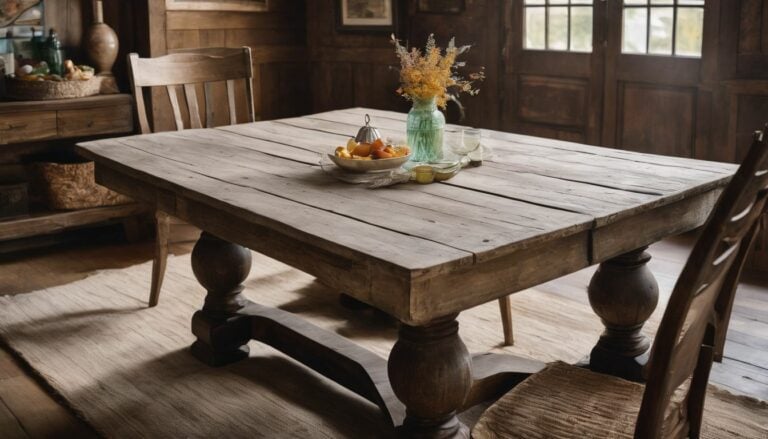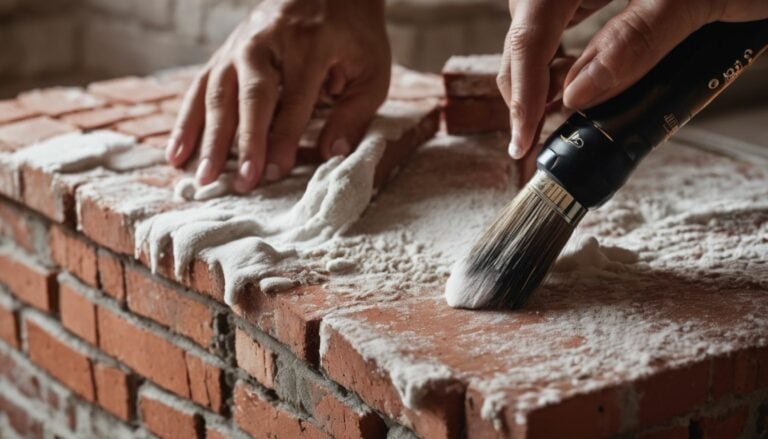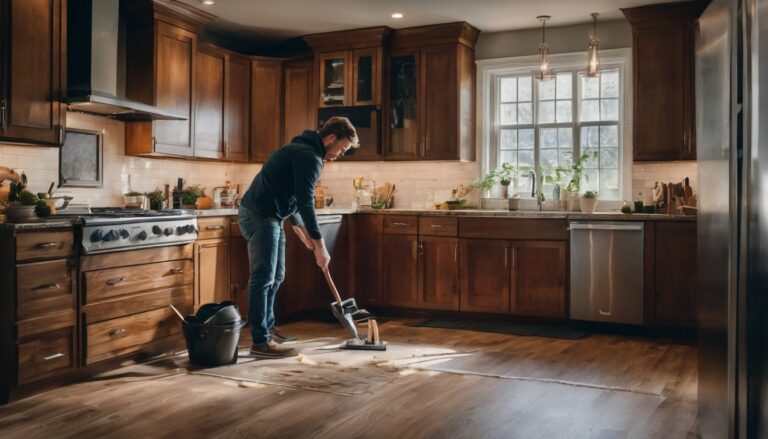How To Remove Kitchen Window: Step-by-Step Guide
Imagine stepping into your kitchen, ready to whip up a delicious meal, only to be greeted by an old, worn-out window that’s seen better days. It’s time for an upgrade!
By removing that outdated window, you can breathe new life into your kitchen. Not only will it give you a chance to choose a stylish replacement window that matches your design preferences, but it can also improve energy efficiency. Say goodbye to drafts and hello to lower utility bills!
Ready to tackle this project? Grab your pliers and let’s get started on removing that old window from its frame. We’ll show you how to create a clean opening for the new window installation and ensure a seamless transition in no time.
Essential Tools and Materials for Removing a Kitchen Window
 Utility Knife, flat pry bar, and hammer laid out next to a kitchen window. the window appears to be in the process of being removed” class=”wp-image-9791″ style=”aspect-ratio:16/9;object-fit:cover”/>
Utility Knife, flat pry bar, and hammer laid out next to a kitchen window. the window appears to be in the process of being removed” class=”wp-image-9791″ style=”aspect-ratio:16/9;object-fit:cover”/>Tools Needed for Removing a Kitchen Window
Before you start tackling the task of removing your kitchen window, it’s important to gather all the necessary tools. Here are the essential tools you’ll need:
- Utility Knife: A utility knife is a versatile tool that will come in handy during the removal process. You can use it to score and cut through any caulking or adhesive around the window frame.
- Flat Pry Bar: A flat pry bar, also known as a crowbar, is an essential tool for removing the window sash and frame. It helps in prying away any trim or molding around the window.
- Hammer: A hammer is needed to gently tap and loosen any stubborn nails or screws holding the window frame in place.
Necessary Materials
In addition to the tools mentioned above, it’s crucial to have all the necessary materials before you begin removing your kitchen window. Here are some materials you’ll need:
- Protective Gloves: Safety should always be a priority when working with glass windows. Wearing protective gloves will protect your hands from potential injuries caused by broken glass shards.
- Safety Goggles: To shield your eyes from flying debris or glass fragments, wear safety goggles throughout the removal process.
- Dust Sheet or Tarp: Place a dust sheet or tarp on the floor beneath the window to catch any falling debris and make cleanup easier afterward.
- Masking Tape: Use masking tape to cover any areas adjacent to the window that you want to protect from accidental scratches or damage during removal.
- Plastic Sheeting: If you’re concerned about dust spreading into other areas of your home, consider hanging plastic sheeting over doorways leading into adjacent rooms.
- Sealant Remover: If there is old caulking or adhesive around your window frame, you may need a sealant remover to soften and remove it effectively.
Safety Equipment for Handling Glass
Working with glass can be risky, so it’s important to take necessary precautions. Here are some safety equipment items you should have:
- Heavy-Duty Gloves: Heavy-duty gloves provide extra protection against cuts and injuries when handling broken glass.
- Safety Shoes: Wearing sturdy safety shoes will protect your feet from any potential hazards during the removal process.
- Dust Mask: To prevent inhalation of dust or debris, wear a dust mask that fits securely over your nose and mouth.
Remember, safety should always come first when working with tools and materials. By having the right tools and protective gear, you’ll be well-prepared to remove your kitchen window safely and efficiently.
Step-by-Step Guide: Removing the Stool and Apron

To successfully remove the stool and apron of your kitchen window, follow these step-by-step instructions. We’ll guide you on how to safely detach these parts without causing any damage to the surrounding areas.
Detaching the Stool
- Start by examining the stool closely. Look for any screws or nails that may be holding it in place.
- If you spot any screws, use a screwdriver to carefully remove them. Place them in a safe spot so they don’t get lost.
- In case there are no visible screws, gently pry the stool away from the window jamb using a putty knife or a flathead screwdriver. Be cautious not to apply excessive force that could damage the woodwork.
- Slowly work your way around all sides of the stool until it becomes loose enough to remove completely.
Removing the Apron
- Once you’ve removed the stool, take a look at the apron beneath it. The apron is located at the bottom of the window frame.
- Depending on its size and construction, some aprons may be attached with screws or nails, while others might be glued in place.
- If there are visible screws or nails, use a screwdriver or hammer to loosen and remove them one by one.
- For glued aprons, you can try gently prying it away from the wall using a putty knife or scraper tool.
- If necessary, heat can also help soften any adhesive holding it in place – just be careful not to overheat or damage nearby surfaces.
Dealing with Stubborn Parts
Sometimes, certain parts of your kitchen window may prove stubborn to remove due to factors like age or layers of paint covering them up. Here are some techniques for dealing with such situations:
- Apply penetrating oil: Use a lubricating oil like WD-40 or a similar product to help loosen stuck parts. Apply the oil generously and allow it to penetrate for a few minutes before attempting to remove the stubborn piece.
- Use a heat gun: If paint is causing the issue, gently heat the area with a heat gun. This will soften the paint, making it easier to scrape away and reveal screws or nails that may be holding the part in place.
- Employ gentle force: When dealing with challenging components, apply steady pressure without excessive force. Use tools like pliers or a pry bar to carefully coax the part loose.
Remember, patience is key when removing stubborn or painted-over parts of your kitchen window. Take your time and proceed cautiously to avoid any unnecessary damage.
Preparing for Replacement: Walling off a Kitchen Window

To ensure a smooth kitchen window replacement process, it’s crucial to wall off the area properly. This helps protect your kitchen from weather elements and maintain access to natural light. Let’s explore different methods of temporarily sealing off the opening and creating an effective barrier.
Understand the Importance of Walling Off
Walling off your kitchen window during replacement serves several purposes. Firstly, it prevents any damage that could occur due to exposure to weather conditions like rain or wind. Secondly, it helps maintain the temperature inside your kitchen by minimizing drafts. Lastly, it ensures that dust and debris from the replacement process don’t spread throughout your home.
Temporary Sealing Methods
There are various ways you can temporarily seal off the opening of your kitchen window:
- Siding: Use siding materials such as plywood or plastic sheeting to cover the window opening. Secure them tightly with screws or nails to create a sturdy barrier against external elements.
- Kitchen Wall: If possible, extend your existing kitchen wall over the window opening using drywall or other suitable materials. This method provides a seamless transition and maintains the aesthetics of your kitchen.
- Side Jambs: Install temporary side jambs on either side of the window opening using wood or metal studs. These jambs act as support structures for attaching temporary barriers like plywood or plastic sheets.
- Painters’ Liner: Consider using painters’ liner, which is a heavy-duty plastic sheeting used by professional painters to protect surfaces during painting projects. It provides excellent protection against moisture and dust.
Tips for Creating an Effective Barrier
While walling off your kitchen window, it’s important to keep in mind these tips for creating an effective barrier:
- Ensure that all edges are sealed tightly to prevent any gaps where air or water could penetrate.
- Use appropriate fasteners like screws or nails to secure the temporary barriers firmly in place.
- If you’re using plastic sheeting, consider reinforcing it with duct tape for added strength and durability.
- Maintain access to natural light by cutting out a small opening in the barrier and covering it with transparent material like clear plastic.
By following these tips, you can create a secure barrier that protects your kitchen during the window replacement process while still allowing sufficient natural light to enter.
Remember, if you’re unsure about any aspect of walling off your kitchen window, it’s always best to consult professionals or refer to reputable home improvement resources like Better Homes & Gardens for guidance.
Types and Parts of Replacement Windows: Installation Guide

We’ll explore the different types available and familiarize ourselves with the various parts that make up these windows. We’ll provide you with some insights on how to install replacement windows in your kitchen.
Explore Various Types of Replacement Windows
There are several options to choose from. Let’s take a look at some popular types:
- Double-Hung Windows: These windows feature two movable sashes that can be opened from both the top and bottom. They provide excellent ventilation and are easy to clean.
- Casement Windows: Casement windows open outward like a door, operated by a crank mechanism. They offer unobstructed views and great airflow control.
- Slider Windows: Slider windows have one fixed sash and another that slides horizontally. They are simple to operate and ideal for kitchens with limited space.
- Awning Windows: Awning windows are hinged at the top and open outward, creating an “awning” effect. They allow fresh air in while keeping rainwater out.
Each type of window has its own advantages, so consider your specific needs when making a decision.
Familiarize Yourself with Different Parts of Replacement Windows
To understand how replacement windows work, it’s important to know their different parts:
- Frames: The frames hold the entire window together and come in various materials such as vinyl, wood, or aluminum.
- Sashes: The sashes are movable portions of the window that hold the glass panes in place.
- Glazing Options: Glazing refers to the glass used in replacement windows. There are different glazing options available, including single-pane, double-pane (with insulating gas), or even triple-pane for enhanced energy efficiency.
By understanding these components, you’ll be better equipped to make informed decisions when choosing replacement windows for your kitchen.
Gain Insights into Best Practices for Installing Replacement Windows
Installing replacement windows in your kitchen can be a daunting task, but with the right approach, it can be a smooth process. Here are some best practices to consider:
- Measure Twice: Before purchasing replacement windows, measure the existing window opening accurately. This ensures a proper fit and minimizes any future issues.
- Prepare the Opening: Remove the old window carefully and clean the opening thoroughly. Check for any damage or rot that needs repair before installing the new window.
- Follow Instructions: Read and follow the manufacturer’s instructions carefully during installation. This will help ensure proper alignment and functionality of the replacement window.
- Seal Properly: Use weatherstripping and caulk to seal any gaps around the window frame. This helps prevent drafts and improves energy efficiency.
- Test for Functionality: After installation, test the window by opening and closing it multiple times to ensure smooth operation.
Remember, if you’re unsure about tackling this project yourself, it’s always wise to consult a professional for assistance.
By exploring different types of replacement windows, familiarizing yourself with their parts, and following best practices during installation, you’ll be well on your way to removing and replacing your kitchen window successfully.
Achieving a Secure Seal: Caulking the Opening
To ensure a secure seal around your kitchen window, it’s important to properly caulk the opening after removing the old window. This step is crucial in preventing drafts, water leakage, and maintaining energy efficiency. Let’s dive into some key points on achieving a secure seal through effective caulking techniques.
Types of Caulks for Sealing Gaps
There are different types of caulks available. Here are some options to consider:
- Silicone Caulk: Known for its flexibility and durability, silicone caulk is an excellent choice for sealing gaps in areas prone to movement. It adheres well to various surfaces and provides a watertight seal.
- Acrylic Latex Caulk: This type of caulk is easy to work with and dries quickly. It’s suitable for both indoor and outdoor use, making it ideal for sealing gaps around kitchen windows.
- Butyl Rubber Caulk: With excellent adhesion properties, butyl rubber caulk forms a strong bond and remains flexible over time. It works well in areas exposed to extreme temperatures.
Applying Caulk Evenly
Once you’ve selected the appropriate caulk for your kitchen window, it’s essential to apply it evenly for long-lasting results. Follow these steps:
- Prepare the Surface: Clean the area around the window opening thoroughly by removing any dirt or debris.
- Masking Tape Application: Apply masking tape along the edges of the casing or flange surrounding the window opening. This will help create clean lines when applying the caulk.
- Cutting the Caulk Tube: Cut off the tip of the caulk tube at a 45-degree angle using a utility knife or scissors.
- Applying Caulk: Hold the caulk gun at a 45-degree angle and apply a steady, even bead of caulk along the gap between the window frame and the opening. Work your way around the entire perimeter.
- Smoothing the Caulk: Use a caulk finishing tool or your finger (dipped in water) to smooth out the caulk, ensuring it fills all gaps evenly.
Key Tips for Effective Caulking
To achieve the best results when caulking your kitchen window, keep these tips in mind:
- Start caulking from one corner and work your way around to maintain consistency.
- Apply enough pressure on the caulk gun to ensure proper flow but avoid excess that could lead to messy application.
- Remove masking tape immediately after smoothing out the caulk to prevent it from drying onto the tape.
- Check for any missed spots or gaps and fill them accordingly.
By following these techniques, you can achieve a secure seal around your kitchen window, preventing drafts, water leakage, and improving energy efficiency.
Exterior Removal: Trim and Sash Weights

In order to successfully remove your kitchen window, you’ll need to tackle the exterior trim and sash weights. Let’s dive into the process step by step.
Learn how to remove exterior trim from your kitchen window prior to replacement.
- Start by carefully inspecting the trim around your window. Look for any visible nails or screws that may be holding it in place.
- Use a pry bar or a putty knife to gently loosen the trim from the wall. Be cautious not to damage the surrounding area.
- Once you’ve loosened the trim, slowly work your way around the window, prying it away from the wall bit by bit.
- If necessary, use a utility knife to cut through any caulk or adhesive that may be securing the trim in place.
- Once all of the trim has been removed, set it aside for disposal later on.
Find out how sash weights are removed and what to do with them during the process.
- Locate the sash weights inside your window frame. These are typically found on either side of the upper sash.
- Use a screwdriver or a wrench to loosen and remove any screws or bolts holding the sash weights in place.
- Carefully lift out each sash weight and set them aside for now.
- It’s important to note that some older windows may have lead-based paint on their sash weights, which can be hazardous if ingested or inhaled. If you suspect lead-based paint, take extra precautions such as wearing gloves and a mask during removal.
Discover tips for safely handling and disposing of old trim and sash weights.
- When handling old trim, be mindful of any sharp edges or protruding nails that could cause injury.
- To dispose of old trim, check with your local waste management facility for guidelines on proper disposal methods. They may require you to separate the trim from other household waste.
- If your sash weights are made of metal, you can recycle them at a local recycling center. However, if they contain lead or other hazardous materials, follow your local regulations for safe disposal.
- Always wear gloves and protective eyewear when handling old trim or sash weights to minimize the risk of injury.
Removing exterior trim and sash weights is an important part of replacing your kitchen window. By following these steps and taking necessary safety precautions, you’ll be well on your way to completing the removal process successfully.
Final Steps: Installing New Trim, Head Stop, and Conclusion

Congratulations! You’ve made it to the final steps of removing your kitchen window. By completing the sections outlined in this blog post, you have gained valuable knowledge and skills to tackle this project successfully. Now it’s time to put the finishing touches on your window replacement.
Installing new trim and a head stop are crucial for achieving a polished and professional look. The trim will enhance the aesthetics of your kitchen while providing structural support. Think of it as adding a beautiful frame to a work of art. And just like that, your new window will become the centerpiece of your kitchen, bringing in natural light and fresh air.
In conclusion, removing a kitchen window may seem like a daunting task at first, but with the right tools and guidance, you can accomplish it with ease. Remember to take your time, follow each step carefully, and don’t hesitate to ask for help if needed. Soon enough, you’ll be enjoying a brand-new window that adds charm and functionality to your kitchen space.
Now that we’ve covered the main sections of this blog post let’s address some common questions that might be on your mind:
FAQs
Can I remove a kitchen window by myself?
Removing a kitchen window is certainly possible as a DIY project. However, it’s important to assess your own skill level and comfort with such tasks before proceeding. If you have experience with basic home improvement projects and feel confident in handling tools safely, then go ahead! But if you’re unsure or uncomfortable working at heights or using power tools, it might be best to hire a professional.
How long does it typically take to remove a kitchen window?
The time required for removing a kitchen window can vary depending on factors such as the size of the window, complexity of its installation, and any unforeseen challenges you may encounter along the way. As an estimate though, allow yourself several hours to complete the process. Remember, it’s better to take your time and do it right than rush through and risk mistakes.
What safety precautions should I take while removing a kitchen window?
Safety should always be a top priority when undertaking any home improvement project. Make sure to wear protective gear such as gloves and safety glasses, especially when handling tools or working with glass. Use proper ladder safety techniques if you need to access higher areas, and be cautious of electrical wiring that may be present around the window.
Can I reuse the old trim when installing a new kitchen window?
In some cases, reusing the old trim may be possible if it’s still in good condition and matches the dimensions of your new window. However, keep in mind that using new trim can provide a cleaner look and ensure a proper fit for your replacement window. New trim materials often come with improved features such as enhanced insulation or resistance to moisture damage.
How do I choose the right replacement window for my kitchen?
Choosing the right replacement window involves considering factors such as energy efficiency, style, durability, and budget. Look for windows with high energy efficiency ratings (such as ENERGY STAR certified windows) to help reduce heating and cooling costs. Consider the architectural style of your kitchen and select a window design that complements it. Durability is also important since kitchens are prone to humidity and temperature fluctuations. Finally, set a budget range beforehand to narrow down your options effectively.







